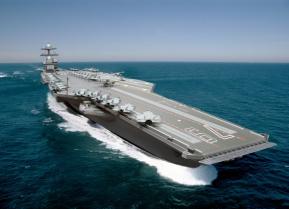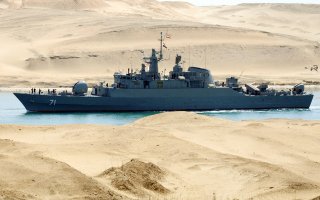Iran's Navy Is Dying a Slow Death
"As Iranian regime rhetoric races ahead of the country’s military capability, however, incidents like the Konarak friendly-fire incident have become more likely. The only question for Tehran will be whether utilizing the navy for military bluster and great power pretensions is worth the cost in both Iranian lives and diplomatic embarrassment."
The Iranian sailors onboard the Dutch-built Hendijan-class Konarak in the Gulf of Oman never saw the missile coming. It struck with devastating impact, killing 19 onboard and wounding many more. The fire was so intense that the Konarak was still on fire as it was towed into the Iranian port of Chahbahar, not far from the Pakistani border.
Supreme Leader Ali Khamenei sent his condolences and, in his capacity as commander-in-chief of the Iranian armed forces, ordered an investigation. “The pain of losing loved ones for their families, and the loss of these sincere, hardworking youth for the naval forces is immense and difficult to bear,” he declared. He might have added that the Iranian Navy is getting used to such mishaps.
The Iranian navy has a proud past. During the 8th century, Persian pirates burned Canton (modern Guangzhou) to the ground. As the Spanish and Portuguese began exploring “the New World,” Persian ships were already plying the Indian Ocean and East Africa. Indeed, Nowruz—the Persian New Year—is still celebrated in some parts of Somalia, even though locals may not remember its roots. In 1971, as the British Navy withdrew from the Persian Gulf, the Shah sent the Iranian Imperial Navy to capture Abu Musa and Greater and Lesser Tonb Islands. After Saddam Hussein’s forces invaded Iran in September 1980, the newly formed Islamic Republic of Iran Navy had its greatest—and last—victory. In a coordinated air and sea assault of which neither Iraqis nor Western military analysts believed Iran capable, the Iranian Navy successfully carried out Operation Morvarid (Pearl), destroying oil rigs and most of Iraq’s small navy at Mina al-Bakr.
For the Iranian Navy, it has been downhill from there. After the Reagan administration ordered the reflagging and escort of Kuwaiti tankers in order to protect an American ally and keep the sea lanes open in the face of Iranian (and Iraqi) attacks, the U.S. Navy and Marines engaged sporadically with their Iranian counterparts. After U.S. forces caught the Iranian Ajr red-handed laying mines in the Persian Gulf, U.S. forces boarded the ship, evacuated its crew, and scuttled it. While many of the mines discovered in the Persian Gulf were unmarked and Iranian diplomats repeatedly denied they were Iranian, the intelligence gathered from Iranian Ajr, including mines not yet deployed, provided an intelligent bonanza; the Islamic Republic could no longer deny responsibility for its actions.
Therefore, when the USS Samuel B. Roberts struck a mine in the Persian Gulf, the Reagan administration did not hesitate to retaliate. On April 18, 1988, the United States Navy moved to attack Iranian oil platforms. As per standard procedure, it gave Iranian personnel five minutes to evacuate. Some begged for more time but, rather than leave for safety, both alerted the Iranian military and sought to fight. The result—Operation Praying Mantis—escalated to become the largest surface naval engagement since World War II. The U.S. Navy decisively defeated both their Iranian counterparts and Iranian jets which also sought to attack. It was this catastrophic defeat that led Iranian strategists to abandon the notion of direct confrontation with the U.S. Navy and embrace of small boat swarming tactics instead.
The Iranian Navy would not regain its prestige within the Iranian order of battle until 2007. In that year, Mohammad Ali Jafari became commander of the Islamic Revolutionary Guard Corps and ordered a fundamental rethink of Iranian deployment. He calculated correctly that the greatest challenge to regime survival would come from Iran’s own people and so reorganized the organization to put one unit in each province with the aim to maintain local control. That same year, Khamenei traveled to Bandar Abbas to address the Iranian Navy and Islamic Revolutionary Guard Corps Navy, charging them with becoming the main mechanisms to project Iranian power. In practice, the Islamic Revolutionary Guard Corps Navy is paramount in the Persian Gulf, jointly operates with the regular Navy in the Strait of Hormuz, and the regular Navy is paramount in the Caspian Sea, Indian Ocean, and Gulf of Aden.
Soon, the Iranian Navy began showing its flag ever farther. In February 2011, the Iranian Navy sent a ship through the Suez Canal and into the Mediterranean for the first time since the Islamic Revolution (Egyptian President Abdel Fattah el-Sisi put an end to Iranian canal crossings, notwithstanding supposed freedom of navigation through the Suez Canal. Then, in 2013, the Iranian Navy undertook its first deployment to the Pacific Ocean since the tenth century, ultimately paying a port call in Zhangjiagang, just north of Shanghai. Whereas once Iranian leaders described the Islamic Republic as a regional power, soon they began to talk about themselves as a pan-regional power (to include not only the Persian Gulf but also the northern Indian Ocean) and finally to define their strategic boundaries as the Gulf of Aden and Eastern Mediterranean.
The Iranian Navy, however, soon grew too ambitious for its capabilities. In 2016, Iranian officials announced they would dispatch an Iranian flotilla to the Atlantic Ocean. They never made it. Mechanical difficulties forced two Iranian ships to make an emergency port call in Durban, South Africa. The Iranian engineers were unable to repair the ships before rations ran out, reportedly forcing the Iranian sailors onto the streets to beg for food. The triumph of an Atlantic deployment turned into a propaganda disaster.
January 2018 was an especially bad month for Iranian shipping. On January 10, 2018, the Iranian destroyer Damavand hit a breakwater while trying to dock at Bandar Anzali in the Caspian Sea. Iranian officials originally described it as a minor incident, but bloggers leaked video of the ship sinking. Ultimately, the Iranian Navy acknowledged the incident and admitted three sailors drowned. Four days later, an Iranian tanker likely smuggling oil to North Korea sank after bursting into flames in the Pacific Ocean, leaving no survivors. It had collided with a Hong Kong ship eight days earlier. Both cases suggest sloppiness and poor training.
The Konarak incident is now the second major Naval accident—the third if the Iranian tanker is included—under the watch of Admiral Hossein Khanzadi who assumed command of the Islamic Republic of Iran Navy in November 2017. Whereas once the Iranian Navy was the pride of state, today it has become a shadow of its former self. As Iranian regime rhetoric races ahead of the country’s military capability, however, incidents like the Konarak friendly-fire incident have become more likely. The only question for Tehran will be whether utilizing the navy for military bluster and great power pretensions is worth the cost in both Iranian lives and diplomatic embarrassment.
Michael Rubin is a resident scholar at the American Enterprise Institute (AEI). You can follow him on Twitter: @mrubin1971.


